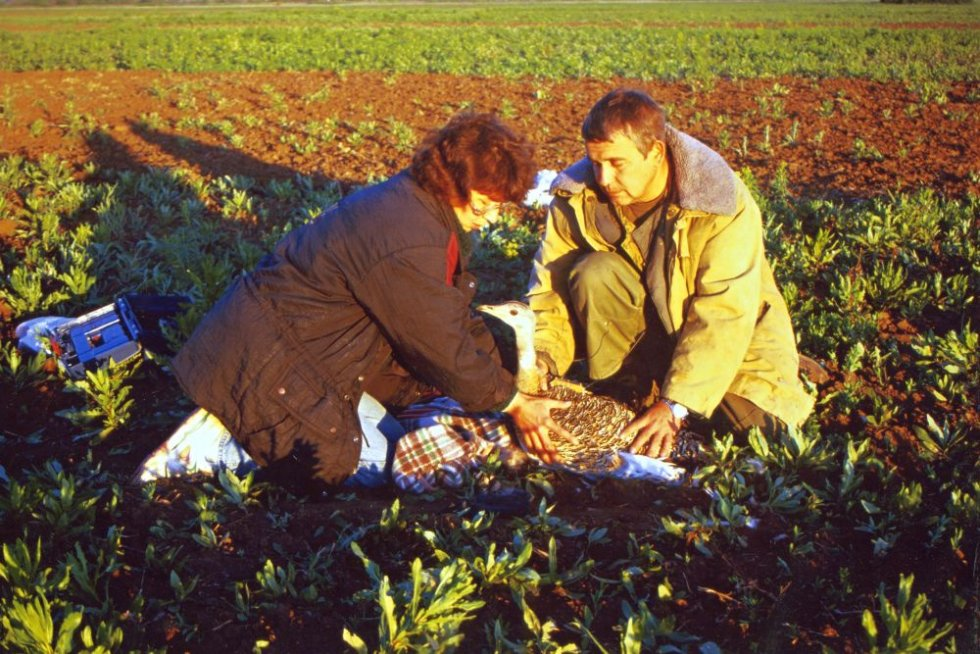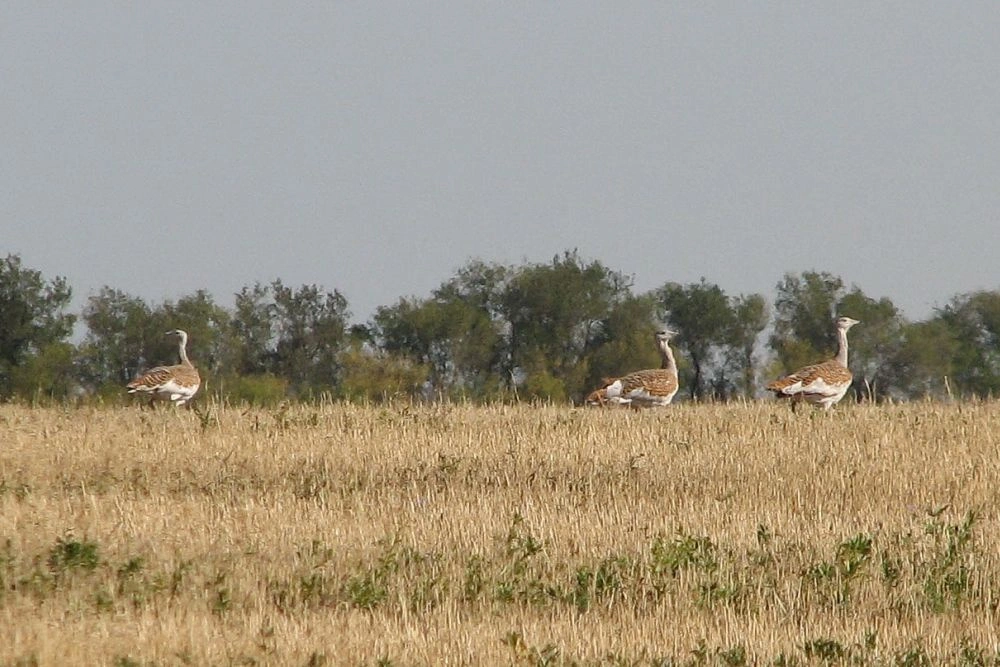
Scientists from the Saratov branch of the A.N. Severtsov Institute of Ecology and Evolution RAS Olga and Mikhail Oparin have been studying the Red Book bird for many years. According to biologists, over the past decades the bustard population in the Volga region has decreased by five to six times.
An eye in the field
The amazing creature has lived in the Volga steppes for thousands of years - the world's largest flying bird, the bustard. Unlike many inhabitants of the steppes, it managed to adapt to human activity. When the steppes were plowed up, these birds learned to make nests and hatch chicks in the fields. Only for the spring flow the bustard chooses untouched areas of virgin soil. Just a couple of centuries ago, large herds of bustards fed throughout the vast Eurasian steppes from the Iberian Peninsula to Manchuria. To our time, they have survived only in separate isolated areas of the steppe.
As Olga Oparina says, bustards are very careful and do not let people get close to them. Scientists most often observe their lives from a distance of one or two kilometers from the nearest forest belt, using strong optics.
It usually takes many hours to monitor a field where bustards are thought to live.
“Suddenly you see through the lens that an eye is looking at you, you begin to observe this place and after some time you notice how the bird’s head has risen and is looking around,” says Olga Sergeevna.
If the next day they manage to spot the bird in the same place, it means that scientists are lucky and have found a female sitting on the nest.
Many clutches of eggs are destroyed when machinery starts working in the fields. Following the tractors are rooks and crows, for whom eggs in a nest abandoned by a bustard are tasty prey.
At the beginning of summer, chicks hatch in the nests. For the first two weeks, the bustard feeds its offspring exclusively with insects, then the grown chicks switch to plant foods. Bustards do not cause damage to agricultural crops, but they themselves destroy weeds, insects and small rodents.
Unlike their European counterparts, who live in the same place - the mild climate allows it, bustards from the Volga region fly south for the winter.
At the end of the 90s of the last century, scientists in the Saratov region conducted a complex experiment - they installed satellite transmitters on several specially captured bustard females to find out their migration routes. As it turned out, bustards from the banks of the Volga fly to spend their winters in the Black Sea region: to the Crimea, to the Kerch Peninsula, to the Kherson and Zaporozhye regions. Birds cover a distance of a thousand kilometers in five to eight days.
At the same time, as ornithologists say, bustards are very attached to the area where they were born. “We thought that after suffering stress, the bustards would not return to the field where they were caught the next year, but we were mistaken, and one of the females flew to this field for three years in a row,” says Olga Oparina.
Reserve with no bustards
Scientists have been monitoring the number of bustards that nest on the so-called “model site” - the territory of nine Trans-Volga districts of the Saratov region - for many years.
At the end of the last century, about three thousand birds lived here, and in total there are about 8-10 thousand bustards in the Volga region. The bustard population on the Volga was considered the second largest in the world, and the largest number of bustards lived in Spain.

The situation with the numbers of the Red Book bird was relatively stable in the late 1990s and early 2000s, when many spring crops were sown, and some fields were not cultivated. However, since the beginning of the 2010s, the situation in agriculture has changed. All fallow lands were plowed, most farmers and agricultural enterprises began to use three-field crop rotation: winter crops, sunflowers, fallows. This regime is unfavorable for bustards. The main thing is that chemicalization in agriculture has sharply increased, and the use of pesticides has increased. As a result, there were fewer pests and weeds in the fields, but at the same time the bustards were left without their food. In addition, due to the excessive use of pesticides, chicks and sometimes adult birds began to die out.
According to observations over the past few years, the number of bustards in the territory where more than three thousand previously lived has decreased to 500-600 birds, that is, it has decreased by five to six times.
...At the end of March and beginning of April, birds return from wintering to their homeland, and almost immediately impressive bustard currents begin in the steppe. According to experts, this is the best time to count the number of bustards. Later, within a radius of approximately ten kilometers from the current site, the birds build their nests.
Over the past twenty years, the number of bustard leks in the Volga region has decreased by half. Now in the territory monitored by scientists, there are only 9-10 of them left.
In the early 80s of the last century, the Saratov Nature Reserve was created on the territory of the Fedorovsky district to protect steppe animals, mainly the bustard (Otis tarda) and little bustard (tetrax tetrax).
“There is a reserve, but there are no bustards there,” says Mikhail Oparin.
Previously, one of the bustard leks was located within the boundaries of the reserve, but now it has disappeared. Last spring, scientists noticed only two displaying males in this territory, which, apparently, flew there by accident.
On the territory of the reserve, the bustard can be protected from poachers, but they are not now the main threat to the population. The main problem is that agricultural work on the territory of the reserve is also not regulated in any way. - The number of bustards is declining due to changes in human economic activity. In order to preserve it, we need interaction between scientists, farmers, and environmental structures, as well as changes to legislation, explains Olga Oparina.
"Mothers" with a pipette
In Europe, where bustards disappeared earlier than in Russia, scientists became concerned about restoring the population of this bird more than half a century ago.
At first they tried to rely on incubating eggs and artificial breeding. But, as it turned out, bustards reproduce in captivity with great difficulty.
In the Saratov region, eggs were also incubated at a biological station in the village of Dyakovka. Now five females and two male bustards live here.
- The chicks are fed with tweezers for the first weeks, and watered with pipettes every hour. In terms of the complexity of care, this can be compared to caring for a premature baby,” says the scientist.
An even more difficult problem is how to adapt the chicks raised in captivity to their natural environment. Even in European countries, where enormous funds have been allocated to restore the population of this bird, the survival rate of released bustards is low. Although, for example, in a national park in Hungary, young bustards are first released into a giant enclosure of 400 hectares, fenced with an electrified fence to protect from predators.
After many years of searches and mistakes in a number of countries, the main direction was to create conditions directly in nature suitable for bustards.
Now they successfully use a mechanism where farmers take on certain obligations: they sow only certain agricultural crops - spring crops, legumes and do not treat the crops with chemicals, and do not make hay in the meadows until the bustards hatch their chicks. For this, agricultural producers receive substantial compensation from the budget.
As a result, the number of bustards in some Central European countries has increased significantly in recent years. For example, in Hungary the population increased from several hundred to 2.7 thousand birds. And Germany, where the bustard had practically disappeared, only a few dozen individuals remained in the wild; now houses more than five hundred birds.
Russian scientists have repeatedly made proposals to provide for the possibility of compensation payments to agricultural producers in our legislation, but so far their proposals have not been heard.
“There are still a lot of declarations about the need to preserve the bustard, but so far nothing has been done for this,” says Mikhail Oparin.
Related materials:
NIA Ecology: "The world's largest flying bird is endangered"
